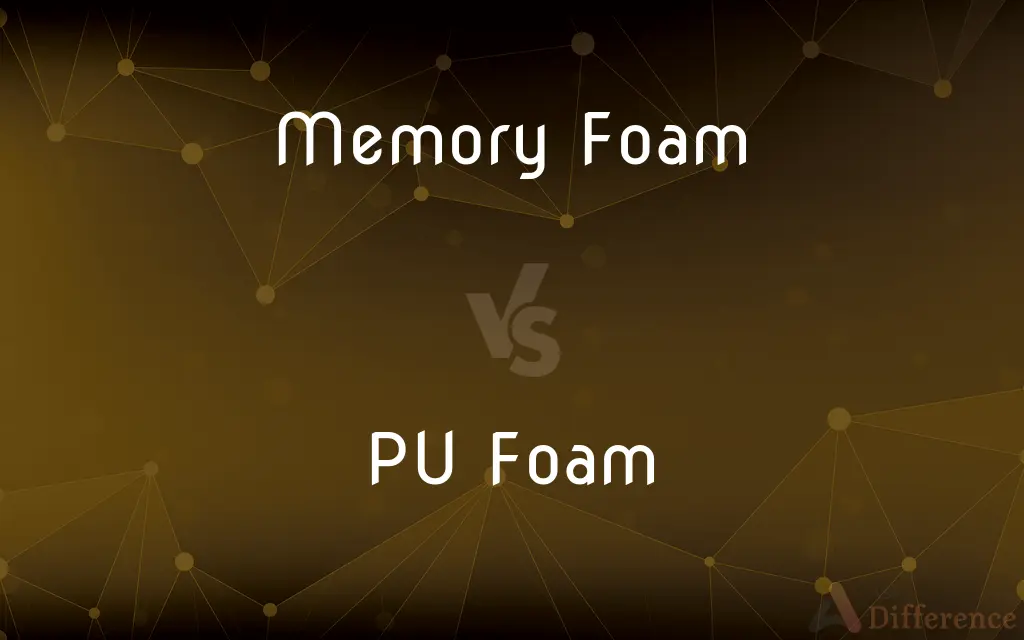Memory Foam vs. PU Foam — What's the Difference?
By Tayyaba Rehman — Published on January 22, 2024
Memory Foam, a viscoelastic material, molds to the body in response to heat and pressure, while PU (Polyurethane) Foam is a lightweight, flexible foam that doesn't conform to pressure as memory foam does.

Difference Between Memory Foam and PU Foam
Table of Contents
ADVERTISEMENT
Key Differences
Memory Foam, developed by NASA, is known for its pressure-relieving properties and ability to contour to the body. This characteristic is due to its viscoelasticity, which allows it to mold in response to heat and pressure. Conversely, PU Foam, or polyurethane foam, is a more general-purpose foam, known for its light weight, flexibility, and resilience, but it does not offer the same contouring properties.
The density of Memory Foam is typically higher than that of PU Foam, contributing to its supportive and pressure-relieving qualities. This higher density can also result in memory foam retaining more heat. PU Foam, with lower density, tends to be more breathable and cooler, but less supportive compared to memory foam.
Memory Foam is often used in products that benefit from its conforming properties, such as mattresses, pillows, and mattress toppers, offering enhanced comfort and support. PU Foam is versatile and used in a variety of applications, including furniture cushions, packaging, and insulation, due to its lightweight and flexible nature.
In terms of durability, Memory Foam tends to be more durable and retain its shape longer due to its density and composition. PU Foam, while durable, may break down faster under constant use, particularly in lower densities.
For individuals with allergies, Memory Foam is often hypoallergenic, resisting dust mites and allergens. PU Foam is also resistant to allergens, but its porous nature can sometimes trap dust and particles.
ADVERTISEMENT
Comparison Chart
Material Properties
Viscoelastic, molds to body
Lightweight, flexible, less conforming
Density
Higher density for support
Lower density, more breathable
Primary Use
Mattresses, pillows, toppers
Furniture cushions, packaging, insulation
Durability
Longer-lasting, retains shape
Less durable, may break down faster
Allergen Resistance
Often hypoallergenic
Resistant but may trap dust
Compare with Definitions
Memory Foam
Known for pressure relief and support.
The memory foam mattress provides excellent back support.
PU Foam
Offers less support but more breathability.
Our PU foam mattress is cooler than memory foam.
Memory Foam
Viscoelastic foam that contours to the body.
My memory foam pillow adjusts to the shape of my head.
PU Foam
Generally more affordable than memory foam.
We chose PU foam for its cost-effectiveness.
Memory Foam
Often used in bedding and comfort products.
We bought a memory foam topper for extra mattress comfort.
PU Foam
Less conforming than memory foam.
The chair's PU foam doesn't mold to my body like memory foam.
Memory Foam
Responds to body heat and pressure.
The memory foam softened with my body heat, offering comfort.
PU Foam
Flexible and lightweight polyurethane material.
The PU foam cushioning made the sofa quite comfortable.
Memory Foam
Denser and more heat-retentive than other foams.
Memory foam mattresses can retain more body heat.
PU Foam
Used in a variety of everyday items.
PU foam is commonly found in packaging materials.
Common Curiosities
What is PU foam?
PU foam, or polyurethane foam, is a flexible, lightweight foam used in various applications.
Does memory foam retain heat?
Yes, memory foam can retain more body heat compared to other types of foam.
Why is memory foam used in mattresses?
Memory foam is used in mattresses for its ability to contour to the body and provide pressure relief.
What is memory foam?
Memory foam is a viscoelastic material that molds to the body in response to heat and pressure.
Is PU foam good for cushions?
Yes, PU foam is commonly used for cushions due to its flexibility and light weight.
Which foam is better for back support?
Memory foam is typically better for back support as it contours to the body and offers better pressure relief.
Can PU foam be used for insulation?
Yes, PU foam is often used in insulation due to its lightweight and flexible properties.
Are memory foam products hypoallergenic?
Many memory foam products are hypoallergenic, resisting dust mites and allergens.
Does memory foam help with joint pain?
Memory foam can help alleviate joint pain by providing better support and reducing pressure points.
How long does memory foam last compared to PU foam?
Memory foam generally lasts longer than PU foam due to its higher density and better shape retention.
Is PU foam more breathable than memory foam?
Yes, PU foam is generally more breathable due to its lower density.
Is PU foam cheaper than memory foam?
Generally, PU foam is more affordable than memory foam.
Is PU foam durable?
PU foam is durable but may break down faster under constant use, especially in lower densities.
Can both memory foam and PU foam be recycled?
Recycling options vary, but generally, both types of foam can be recycled depending on local facilities.
Can I get a memory foam mattress topper?
Yes, memory foam mattress toppers are popular for adding comfort and support to existing mattresses.
Share Your Discovery

Previous Comparison
Green Chemistry vs. Environmental Chemistry
Next Comparison
Western Digital Hard Disk vs. Seagate Hard DiskAuthor Spotlight
Written by
Tayyaba RehmanTayyaba Rehman is a distinguished writer, currently serving as a primary contributor to askdifference.com. As a researcher in semantics and etymology, Tayyaba's passion for the complexity of languages and their distinctions has found a perfect home on the platform. Tayyaba delves into the intricacies of language, distinguishing between commonly confused words and phrases, thereby providing clarity for readers worldwide.
















































